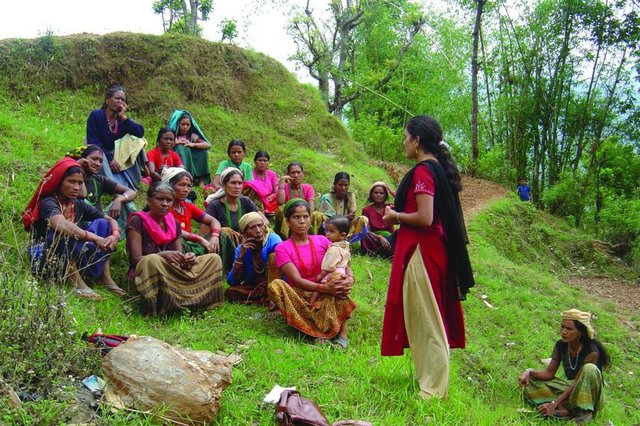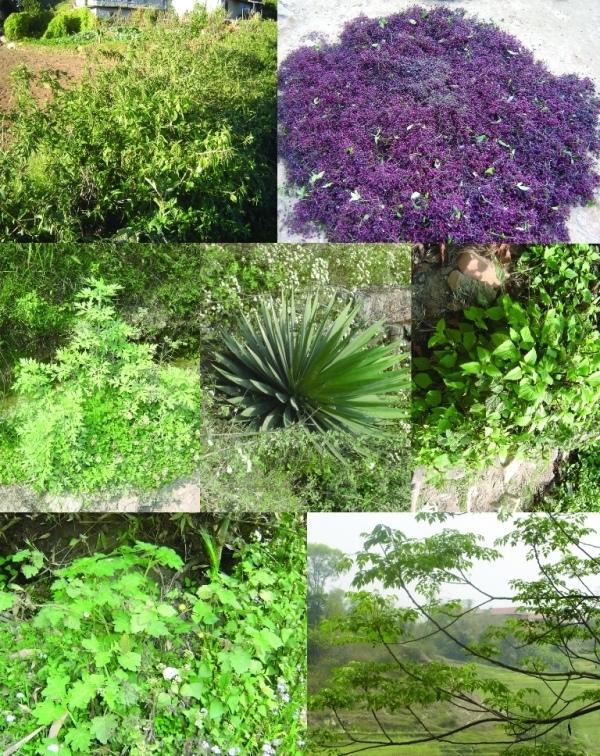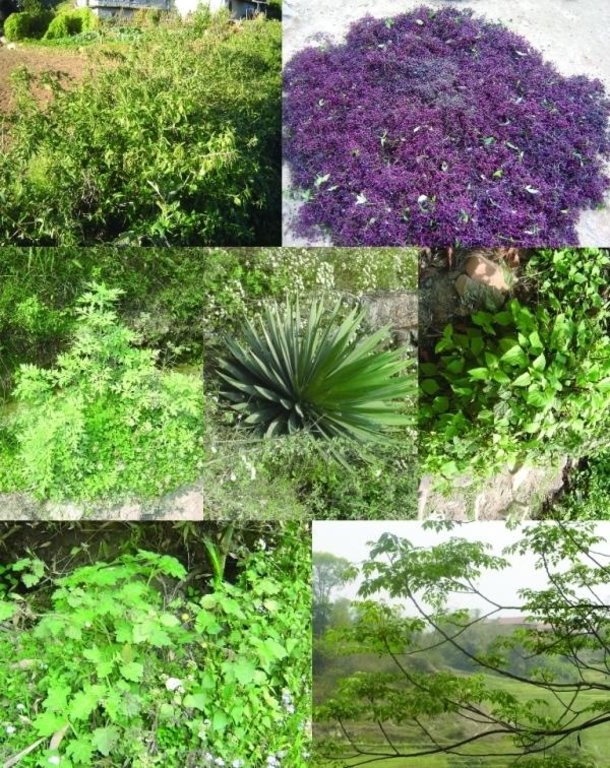Organic pest management [ប្រទេសនេប៉ាល់]
- ការបង្កើត៖
- បច្ចុប្បន្នភាព
- អ្នកចងក្រង៖ Richard Allen
- អ្នកកែសម្រួល៖ –
- អ្នកត្រួតពិនិត្យ David Streiff
Jaibik rogkira byabasthapan (Nepali)
technologies_1755 - ប្រទេសនេប៉ាល់
ពិនិត្យមើលគ្រប់ផ្នែក
ពង្រីកមើលទាំងអស់ បង្រួមទាំងអស់1. ព័ត៌មានទូទៅ
1.2 ព័ត៌មានលម្អិតពីបុគ្គលសំខាន់ៗ និងស្ថាប័នដែលចូលរួមក្នុងការវាយតម្លៃ និងចងក្រងឯកសារនៃបច្ចេកទេស
អ្នកជំនាញឯកទេស SLM:
Director
+977 1 5520314
Soil Management Directorate, Department of Agriculture
ប្រទេសនេប៉ាល់
អ្នកជំនាញឯកទេស SLM:
Team Leader
+977 1 5543591
ssmp@helvetas.org.np
Sustainable Soil Management Programme
ប្រទេសនេប៉ាល់
ឈ្មោះគម្រោងដែលបានចងក្រងឯកសារ/ វាយតម្លៃលើបច្ចេកទេស (បើទាក់ទង)
Sustainable Soil Management Programme, Nepal (SSMP)ឈ្មោះអង្គភាពមួយ (ច្រើន) ដែលបានចងក្រងឯកសារ/ វាយតម្លៃបច្ចេកទេស (បើទាក់ទង)
Department of Agriculture, Soil Management Directorate, Hariharbhawan Lalitpur (doasoil) - ប្រទេសនេប៉ាល់ឈ្មោះអង្គភាពមួយ (ច្រើន) ដែលបានចងក្រងឯកសារ/ វាយតម្លៃបច្ចេកទេស (បើទាក់ទង)
HELVETAS (Swiss Intercooperation)1.3 លក្ខខណ្ឌទាក់ទងទៅនឹងការប្រើប្រាស់ទិន្នន័យដែលបានចងក្រងតាមរយៈ វ៉ូខេត
តើពេលណាដែលទិន្នន័យបានចងក្រង (នៅទីវាល)?
06/11/2008
អ្នកចងក្រង និង(បុគ្គលសំខាន់ៗ)យល់ព្រមទទួលយកនូវលក្ខខណ្ឌនានាទាក់ទងទៅនឹងការប្រើប្រាស់ទិន្នន័យដែលបានចងក្រងតាមរយៈវ៉ូខេត:
បាទ/ចា៎
1.5 ការយោងទៅលើកម្រងបញ្ជីសំណួរនៃវិធីសាស្ត្រផ្សព្វផ្សាយ SLM

Farmer field schools on integrated plant nutrient systems [ប្រទេសនេប៉ាល់]
Participatory and collaborative learning through the farmer field school approach
- អ្នកចងក្រង៖ Richard Allen

Farmer-led experimentation [ប្រទេសនេប៉ាល់]
Participatory technology testing and adaptation through farmer-led experiments
- អ្នកចងក្រង៖ Richard Allen

Farmer-to-farmer diffusion [ប្រទេសនេប៉ាល់]
Wider diffusion of sustainable soil management technologies through a demand responsive farmer-to-farmer diffusion approach
- អ្នកចងក្រង៖ Richard Allen
2. ការពណ៌នាពីបច្ចេកទេស SLM
2.1 ការពណ៌នាដោយសង្ខេបពីបច្ចេកទេស
និយមន័យបច្ចេកទេស:
Promotion of botanical pesticides for organic pest management and liquid manure
2.2 ការពណ៌នាលម្អិតពីបច្ចេកទេស
ការពណ៌នា:
Production of fresh vegetable is often hampered by pests which may reduce production and badly affect farmers’ income. Chemical pesticides are available and are used, sometimes excessively, to combat these pests in parts of Nepal’s midhills. Botanical pesticides prepared from a variety of plant ingredients soaked and fermented in cattle urine provide a suitable alternative to chemical pesticides, at least for subsistence and semi-commercial vegetable producers. These pesticides are based on farmer’s traditional knowledge and are emerging as alternatives to the
application of chemical pesticides.
All the ingredients for these pesticides are available locally; in some cases the plants are considered as weeds. Crofton weed (banmara) grows in abundance along roads and paths, and on forest floors and suppresses the growth of other more valuable species. It is believed to have pesticidal effects and is often used in botanical pesticides. The Nepali names of other plants commonly used in the tonics are asuro (malabara tree), titepati (mugwort), bakaino (Persian lilac), timur (Nepali pepper), patina (field mint), tulsi (sweet basil), neem, sisnu (stinging nettle), ketuke
(century plant), and khirro (tallow tree). In general it is said that herbs and plants that are bitter, pungent, or ‘hot’ or that produce a strong odour are most effective in botanical pesticides.
The botanical pesticide is diluted with water before applying to vegetable crops. The dilution ratio depends on the age and type of the plant being treated with a higher dilution for seedlings in nurseries than for mature plants. While botanical pesticides do not kill all pests, they do combat soft-bodied insects such as aphids and act as a repellent against larger insects like cutworms, various larvae, and red ants. They are not usually effective against plant diseases.
In some places innovative farmers have started to produce and sell botanical pesticides for pest management and as a liquid manure for foliar application.
2.3 រូបភាពនៃបច្ចេកទេស
2.5 ប្រទេស/តំបន់/ទីតាំងកន្លែង ដែលបច្ចេកទេសត្រូវបានអនុវត្ត និងបានគ្រប់ដណ្តប់ដោយការវាយតម្លៃនេះ
ប្រទេស:
ប្រទេសនេប៉ាល់
បញ្ជាក់បន្ថែមពីលក្ខណៈនៃទីតាំង:
Midhills districts of Nepal
Map
×3. ចំណាត់ថ្នាក់នៃបច្ចេកទេស SLM
3.1 គោលបំណងចម្បង (១ ឬច្រើន) នៃបច្ចេកទេសនេះ
- Cheaper pest management
3.2 ប្រភេទដីប្រើប្រាស់មួយប្រភេទ (ច្រើនប្រភេទ) ដែលបានអនុវត្តបច្ចេកទេស

ដីដាំដំណាំ
- ដំណាំប្រចាំឆ្នាំ
មតិយោបល់:
Major land use problems (compiler’s opinion): Intensifying cultivation practices and the increasing demand for fresh and off-season vegetables have increased the
incidence of pests. These pests are controlled mainly by chemical pesticides where available, and where they are not
available entire crops can be destroyed and farmers’ livelihoods endangered.
3.4 ក្រុម SLM ដែលបច្ចេកទេសស្ថិតនៅក្នុង
- បញ្ចូលការគ្រប់គ្រងសត្វល្អិត និងជំងឺតាមបែបចម្រុះ (រួមទាំង កសិកម្មសរីរាង្គ)
3.5 ការសាយភាយនៃបច្ចេកទេស
បញ្ជាក់ពីការសាយភាយនៃបច្ចេកទេស:
- ត្រូវបានផ្សព្វផ្សាយត្រឹមតំបន់មួយ
3.6 វិធានការ SLM ដែលបញ្ចូលនូវបច្ចេកទេស

វិធានការគ្រប់គ្រង
- M7: ផ្សេងៗ
3.7 កំណត់ប្រភេទនៃការធ្លាក់ចុះគុណភាពដីសំខាន់ៗដែលបច្ចេកទេសនេះបានដោះស្រាយ

ការធ្លាក់ចុះសារធាតុគីមីក្នុងដី
- Cn: ការថយចុះជីជាតិ និងកាត់បន្ថយបរិមាណសារធាតុសរីរាង្គ (មិនកើតឡើងដោយការហូរច្រោះទេ)
3.8 ការពារ កាត់បន្ថយ ឬស្តារឡើងវិញនៃការធ្លាក់ចុះគុណភាពដី
បញ្ជាក់ពីគោលដៅរបស់បច្ចេកទេស ដែលផ្តោតទៅការធ្លាក់ចុះគុណភាពដី:
- ការកាត់បន្ថយការធ្លាក់ចុះគុណភាពដី
4. បច្ចេកទេសជាក់លាក់ សកម្មភាពអនុវត្ត ធាតុចូល និងថ្លៃដើម
4.2 លក្ខណៈពិសេសនៃបច្ចេកទេស/ ពណ៌នាពីគំនូរបច្ចេកទេស
Technical knowledge required for field staff / advisors: low
Technical knowledge required for land users: low
Main technical functions: reduction in application of chemical pesticides, reduction in application of chemicalfertilisers
Secondary technical functions: supplementary irrigation
4.3 ព័ត៌មានទូទៅដែលពាក់ព័ន្ធនឹងការគណនាធាតុចូល និងថ្លៃដើម
កំណត់របៀបនៃការគណនាថ្លៃដើម និងធាតុចូល:
- ក្នុងតំបន់អនុវត្តបច្ចេកទេស
កំណត់រូបិយប័ណ្ណសម្រាប់ថ្លៃដើម:
- ដុល្លារអាមេរិក
កំណត់ថ្លៃឈ្នួលជាមធ្យមនៃការជួលកម្លាំងពលកម្មក្នុងមួយថ្ងៃ:
2.00
4.4 សកម្មភាពបង្កើត
| សកម្មភាព | ប្រភេទវិធានការ | ពេលវេលា | |
|---|---|---|---|
| 1. | Different plants with pesticidal properties are collected and chopped into small pieces. Only tenderparts should be used to facilitate decomposition. | ការគ្រប់គ្រង | |
| 2. | Other materials like ginger powder, green chilli, ash, and mustard cake are mixed with the chopped plant material | ការគ្រប់គ្រង | |
| 3. | The material is placed in a plastic drum or earthen pot and soaked in cattle urine at the rate of about one kilogramme of solid material per 2 litres of cattle urine. | ការគ្រប់គ្រង | |
| 4. | The drum is close as air-tight as possible and put in a shady place. | ការគ្រប់គ្រង |
4.5 ថ្លៃដើម និងធាតុចូលដែលត្រូវការសម្រាប់ការបង្កើតបច្ចេកទេស
| បញ្ជាក់ពីធាតុចូល | ឯកតា | បរិមាណ | ថ្លៃដើមក្នុងមួយឯកតា | ថ្លៃធាតុចូលសរុប | % នៃថ្លៃដើមដែលចំណាយដោយអ្នកប្រើប្រាស់ដី | |
|---|---|---|---|---|---|---|
| កម្លាំងពលកម្ម | Labour | Persons/day | 2,0 | 2,0 | 4,0 | 100,0 |
| សម្ភារៈ | Drum | pieces | 1,0 | 6,0 | 6,0 | 100,0 |
| ថ្លៃដើមសរុបក្នុងការបង្កើតបច្ចេកទេស | 10,0 | |||||
4.6 សកម្មភាពថែទាំ
| សកម្មភាព | ប្រភេទវិធានការ | ពេលវេលា/ ភាពញឹកញាប់ | |
|---|---|---|---|
| 1. | The botanical pesticide needs to be stirred with a wooden stick about every 15 days. | ការគ្រប់គ្រង | |
| 2. | The prepared pesticide is normally ready for field application after about 35-40 days of fermentation/preservation. | ការគ្រប់គ្រង | |
| 3. | The pesticide is diluted with water 1:4 (1 part pesticide solution: 4 parts water) for mature plants and 1:8 for nurseries and applied with a jug, sprayer, or broom. | ការគ្រប់គ្រង |
4.7 កំណត់ថ្លៃដើមសម្រាប់ការថែទាំ/ សកម្មភាពរបស់បច្ចេកទេស (ក្នុងរយៈពេលមួយឆ្នាំ)
មតិយោបល់:
Cost as in January 2007
5. លក្ខណៈបរិស្ថានធម្មជាតិ និងមនុស្ស
5.1 អាកាសធាតុ
បរិមាណទឹកភ្លៀងប្រចាំឆ្នាំ
- < 250 មម
- 251-500 មម
- 501-750 មម
- 751-1,000 មម
- 1,001-1,500 មម
- 1,501-2,000 មម
- 2,001-3,000 មម
- 3,001-4,000 មម
- > 4,000 មម
លក្ខណៈពិសេស/ មតិយោបល់លើរដូវភ្លៀង:
Annual rainfall: Also 2000-3000 mm
តំបន់កសិអាកាសធាតុ
- សើម
Thermal climate class: subtropics
5.2 សណ្ឋានដី
ជម្រាលជាមធ្យម:
- រាបស្មើ (0-2%)
- ជម្រាលតិចតួច (3-5%)
- មធ្យម (6-10%)
- ជម្រាលខ្ពស់បន្តិច (11-15%)
- ទីទួល (16-30%)
- ទីទួលចោត (31-60%)
- ទីទួលចោតខ្លាំង (>60%)
ទម្រង់ដី:
- ខ្ពង់រាប
- កំពូលភ្នំ
- ជម្រាលភ្នំ
- ជម្រាលទួល
- ជម្រាលជើងភ្នំ
- បាតជ្រលងភ្នំ
តំបន់តាមរយៈកម្ពស់ :
- 0-100 ម
- 101-500 ម
- 501-1,000 ម
- 1,001-1,500 ម
- 1,501-2,000 ម
- 2,001-2,500 ម
- 2,501-3,000 ម
- 3,001-4,000 ម
- > 4,000 ម
មតិយោបល់ និងបញ្ចាក់បន្ថែមអំពីសណ្ឋានដី :
Slopes on average: Also moderate (6-10%), rolling (11-15%) and hilly (16-30%)
Landforms: Also footslopes
Altitudinal zone: Also 1000-1500 m a.s.l., 1500-2000 m a.s.l. and 2000-2500 m a.s.l.
5.6 លក្ខណៈនៃអ្នកប្រើប្រាស់ដីដែលអនុវត្តបច្ចេកទេស
ទីផ្សារនៃប្រព័ន្ធផលិតកម្ម:
- ពាក់កណ្តាលពាណិជ្ជកម្ម (ផ្គត់ផ្គង់ខ្លួនឯង/ ពាណិជ្ជកម្ម
ឯកជន ឬក្រុម:
- ធ្វើខ្លួនឯង/ គ្រួសារ
សូមបញ្ជាក់ពីលក្ខណៈពាក់ព័ន្ធផ្សេងទៀតអំពីអ្នកប្រើប្រាស់ដី:
Off-farm income specification: In most farm households off-farm income plays at least a minor and increasingly a major role. Occasional opportunities for off-farm income present themselves in the form of daily labour wages. Some households’ members receive regular salaries whilst an increasing number of Nepalis are working in India, the Middle East, Malaysia and elsewhere and sending remittance incomes home.
5.7 ទំហំផ្ទៃដីជាមធ្យមនៃដីផ្ទាល់ខ្លួន ឬជួលគេដែលបានអនុវត្តបច្ចេកទេស
- < 0.5 ហិកតា
- 0.5-1 ហិកតា
- 1-2 ហិកតា
- 2-5 ហិកតា
- 5-15 ហិកតា
- 15-50 ហិកតា
- 50-100 ហិកតា
- 100-500 ហិកតា
- 500-1,000 ហិកតា
- 1,000-10,000 ហិកតា
- > 10,000 ហិកតា
5.8 ភាពជាម្ចាស់ដី កម្មសិទ្ធប្រើប្រាស់ដី និងកម្មសិទ្ធប្រើប្រាស់ទឹក
ភាពជាម្ចាស់ដី:
- ឯកជន មិនមានកម្មសិទ្ធ
- ឯកជន មានកម្មសិទ្ធ
កម្មសិទ្ធិប្រើប្រាស់ដី:
- កិច្ចសន្យាជួល
- ឯកជន
មតិយោបល់:
Sharecropping between owner and tenant
6. ផលប៉ះពាល់ និងការសន្និដ្ឋាន
6.1 ផលប៉ះពាល់ក្នុងបរិវេណអនុវត្តបច្ចេកទេសដែលកើតមាន
ផលប៉ះពាល់លើសេដ្ឋកិច្ចសង្គម
ចំណូល និងថ្លៃដើម
ការចំណាយលើធាតុចូលកសិកម្ម
បន្ទុកការងារ
មតិយោបល់/ ការបញ្ជាក់:
Labor- intensive preparation of botanical pesticides. Need to be prepared fresh for each crop, therefore demanding labor often at inconvenient times
ផលប៉ះពាល់ទៅលើសេដ្ឋកិច្ចសង្គមផ្សេងៗ
Pest incedence and destruction of crops
Crop health
មតិយោបល់/ ការបញ្ជាក់:
due to additional fertilizer
Organicproduction of crops
ផលប៉ះពាល់ទៅលើវប្បធម៌សង្គម
Social prestige as use shows user to be a progressive farmer
Acceptance of the fertilizer
មតិយោបល់/ ការបញ្ជាក់:
May not be accepted due to urine in the mixture ( especially if human urine is used)
ផលប៉ះពាល់ទៅលើអេកូឡូស៊ី
ផលប៉ះពាល់ទៅលើអេកូឡូស៊ីផ្សេងៗ
Application of agrochemcals
Soil biology health
6.2 ផលប៉ះពាល់ក្រៅបរិវេណអនុវត្តបច្ចេកទេសដែលកើតមាន
ទឹកក្រោមដី/ ការបំពុលទឹកទន្លេ
មតិយោបល់/ ការបញ្ជាក់:
Reduction of chemical pesticide contamination of water bodies
Dependence on oncostly external inputs
6.4 ការវិភាគថ្លៃដើម និងអត្ថប្រយោជន៍
តើផលចំណេញ និងថ្លៃដើមត្រូវបានប្រៀបធៀបគ្នាយ៉ាងដូចម្តេច (ទស្សនៈរបស់អ្នកប្រើប្រាស់ដី)?
រយៈពេលខ្លី:
វិជ្ជមាន
រយៈពេលវែង:
វិជ្ជមាន
តើផលចំណេញ និងការថែទាំ/ ជួសជុលត្រូវបានប្រៀបធៀបគ្នាយ៉ាងដូចម្តេច (ទស្សនៈរបស់អ្នកប្រើប្រាស់ដី)?
រយៈពេលខ្លី:
វិជ្ជមាន
រយៈពេលវែង:
វិជ្ជមាន
6.5 ការទទួលយកបច្ចេកទេស
មតិយោបល់:
Comments on spontaneous adoption: It is adopted by small to medium scale, 50% of SSMP trained/organised groups and 10% of local farmers from outside the SSMP groups were using the technology.
6.7 ភាពខ្លាំង/ គុណសម្បត្តិ/ ឱកាសនៃបច្ចេកទេស
| ភាពខ្លាំង/ គុណសម្បត្តិ/ ឱកាស ទស្សនៈរបស់បុគ្គលសំខាន់ៗ |
|---|
|
Organic pest management using botanical pesticides reduce the expense of pest control How can they be sustained / enhanced? Further promote the benefits of organic pest management |
|
Organic pest management reduces the negative impact of chemical pesticides How can they be sustained / enhanced? Further promote the benefits of organic pest management |
6.8 ភាពខ្សោយ/ គុណវិបត្តិ/ ហានិភ័យនៃបច្ចេកទេស និងវិធីសាស្ត្រដោះស្រាយ
| ភាពខ្សោយ/ គុណវិបត្តិ/ ហានិភ័យ ទស្សនៈរបស់អ្នកចងក្រងឬបុគ្គលសំខាន់ៗ | តើបច្ចេកទេសទាំងនោះបានដោះស្រាយបញ្ហាដូចម្តេច? |
|---|---|
| Labour intensive preparation often at inconvenient times as the botanical pesticide has to be prepared fresh for each crop and can only be stored for a limited amount of time | Develop methods that reduce labour requirements and highlight possibilities for bulk production and adequate storage without losing effectiveness |
| The reagents that are effective in the botanical pesticides have not been identified |
Carry out applied research into the different reagents and their effect on different pests |
| The botanical pesticides are not effective against all pests | Carry out applied research into and document the effects of different botanical pesticides on different pests |
7. ឯកសារយោង និងវេបសាយ
7.2 ឯកសារយោងដែលបានចេញផ្សាយ
ចំណងជើង អ្នកនិពន្ធ ឆ្នាំ ISBN:
Neupane, F.P. (2056 BS - 1999/2000) Insect Control by Herbs. Kathmandu: Sajha Publications
មានប្រភពមកពីណា? ថ្លៃដើមប៉ុន្មាន?
SSMP
ចំណងជើង អ្នកនិពន្ធ ឆ្នាំ ISBN:
Several pamphlets on different tonal tonic compositions are available in Nepali from SSMP
មានប្រភពមកពីណា? ថ្លៃដើមប៉ុន្មាន?
SSMP
ការតភ្ជាប់ និងម៉ូឌុល
ពង្រីកមើលទាំងអស់ បង្រួមទាំងអស់ការតភ្ជាប់

Farmer field schools on integrated plant nutrient systems [ប្រទេសនេប៉ាល់]
Participatory and collaborative learning through the farmer field school approach
- អ្នកចងក្រង៖ Richard Allen

Farmer-led experimentation [ប្រទេសនេប៉ាល់]
Participatory technology testing and adaptation through farmer-led experiments
- អ្នកចងក្រង៖ Richard Allen

Farmer-to-farmer diffusion [ប្រទេសនេប៉ាល់]
Wider diffusion of sustainable soil management technologies through a demand responsive farmer-to-farmer diffusion approach
- អ្នកចងក្រង៖ Richard Allen
ម៉ូឌុល
គ្មានម៉ូឌុល





